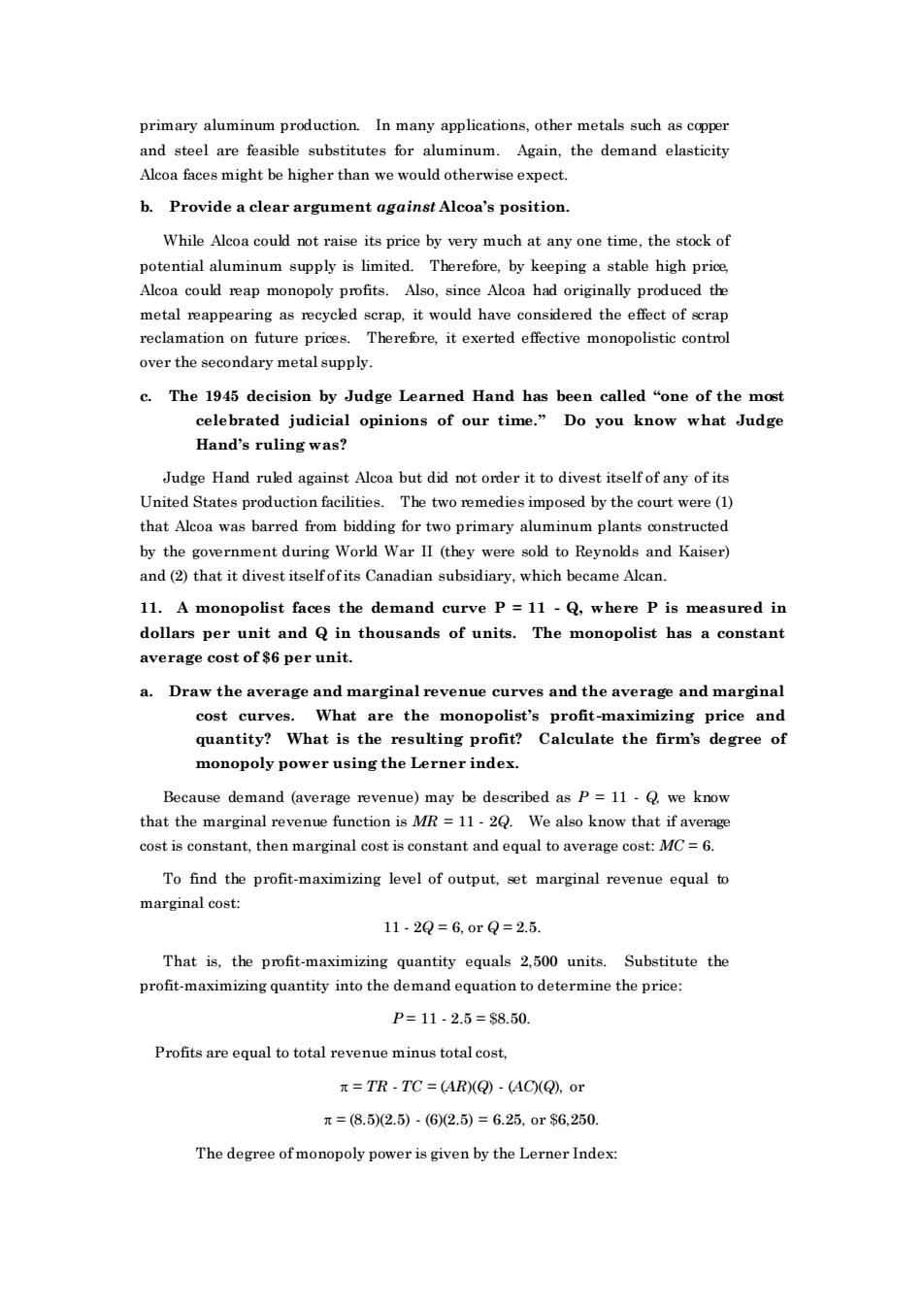正在加载图片...

primary aluminum production.In many applications,other metals such as coppe and steel are feasible substitutesfor aluminum Again,the demand elasticity Alcoa faces might be higher than we would otherwise expect. b.Provide a clear argument against Alcoa's position While Alcoa coul not raise its price by very much at any one time,the stock of potential aluminum supply is limited.Therefore,by keeping a stable high price Alcoa coul reap monopoly profits.Also,since Alcoa had originally produced the metal erap it would have the n futur T erefre,it exerte d ctive monopolist c contr over the secondary metal supply. e.The 1945 decision by Judge Learned Hand has been called "one of the most celebrated judicial opinions of our time."Do you know what Judge Hand's ruling was? Judge Hand ruled against Alcoa but did not order it to divest itself of any of its United States production facilities.The two remedies imposed by the court were (1) that Alcoa was barred from bidding for two primary aluminum plants by the government during Worl War II (they were sold to Reynolds and Kaiser) and(2)that it divest itselfofits Canadian subsidiary.which became Alcan. 11.A monopolist faces the demand curve P=11-Q,where P is measured in dollars per unit and Q in thousands of units.The monopolist has a constant average cost of $6 per unit. a.Draw the average and marginal revenue curves and the ave and marginal cost c e What are the monop list price and quantity?What is the resulting profit?Calculate the firm's degree of monopoly power using the Lerner index. Because demand (average revenue)may be described as P=11-A we know that the marginal revenue function is MR=11-20.We also know that if average cost is constant.then marginal cost is constant and equal to average cost:MC=6. To find the profit-maximizing level of output.set marginal revenue equal to marginal cost 112Q=6,orQ=2.5 That is,the profit-maximizing quantity equals 2,500 units.Substitute the profit-maximizing quantity into the demand equation to determine the price: P=11-2.5=$8.50 Profits are equal to total revenue minus total cost, I=TR-TC=(AR)(Q)-(AC)(Q),or 元=8.52.5)-(62.5)=6.25.ors6,250. The degree of monopoly power is given by the Lerner Index:primary aluminum production. In many applications, other metals such as copper and steel are feasible substitutes for aluminum. Again, the demand elasticity Alcoa faces might be higher than we would otherwise expect. b. Provide a clear argument against Alcoa’s position. While Alcoa could not raise its price by very much at any one time, the stock of potential aluminum supply is limited. Therefore, by keeping a stable high price, Alcoa could reap monopoly profits. Also, since Alcoa had originally produced the metal reappearing as recycled scrap, it would have considered the effect of scrap reclamation on future prices. Therefore, it exerted effective monopolistic control over the secondary metal supply. c. The 1945 decision by Judge Learned Hand has been called “one of the most celebrated judicial opinions of our time.” Do you know what Judge Hand’s ruling was? Judge Hand ruled against Alcoa but did not order it to divest itself of any of its United States production facilities. The two remedies imposed by the court were (1) that Alcoa was barred from bidding for two primary aluminum plants constructed by the government during World War II (they were sold to Reynolds and Kaiser) and (2) that it divest itself of its Canadian subsidiary, which became Alcan. 11. A monopolist faces the demand curve P = 11 - Q, where P is measured in dollars per unit and Q in thousands of units. The monopolist has a constant average cost of $6 per unit. a. Draw the average and marginal revenue curves and the average and marginal cost curves. What are the monopolist’s profit -maximizing price and quantity? What is the resulting profit? Calculate the firm’s degree of monopoly power using the Lerner index. Because demand (average revenue) may be described as P = 11 - Q, we know that the marginal revenue function is MR = 11 - 2Q. We also know that if average cost is constant, then marginal cost is constant and equal to average cost: MC = 6. To find the profit-maximizing level of output, set marginal revenue equal to marginal cost: 11 - 2Q = 6, or Q = 2.5. That is, the profit-maximizing quantity equals 2,500 units. Substitute the profit-maximizing quantity into the demand equation to determine the price: P = 11 - 2.5 = $8.50. Profits are equal to total revenue minus total cost, = TR - TC = (AR)(Q) - (AC)(Q), or = (8.5)(2.5) - (6)(2.5) = 6.25, or $6,250. The degree of monopoly power is given by the Lerner Index: